From MyFunCity to government-structured approach to “digital citizenship,” this is recent trend, which is seriously considered by educators as a must in the curricula. While habitually connected with technology classes, it is a much larger issue, which requires faculty attention across disciplines; it encompass digital and technology literacy, netiquette and online behavior (cyberbulling most frequently addressed), as well qualities and skills to be a functional and mindful citizen of a global world.
here is some general literature on digital citizenship:
Digital Citizenship: The Internet, Society, and Participation
http://groups.lis.illinois.edu/guest_lectures/cii/digcitizen.pdf
Digital Citizenship: Addressing Appropriate Technology Behavior
Ribble, Mike S.; Bailey, Gerald D.; Ross, Tweed W.
Learning & Leading with Technology, v32 n1 p6-9, 11 Sep 2004
Techné: Research in Philosophy and Technology
Volume 9, Issue 1, Fall 2005. Education and Citizenship in the Digital Age
Isman, A., & Canan Gungoren, O. (2014). Digital Citizenship. Turkish Online Journal Of Educational Technology – TOJET, 13(1), 73-77. http://eric.ed.gov/?id=EJ1018088
PR, N. (2014, April 3). MyFunCity is a revolution in digital citizenship. PR Newswire US. http://login.libproxy.stcloudstate.edu/login?qurl=http%3a%2f%2fsearch.ebscohost.com%2flogin.aspx%3fdirect%3dtrue%26db%3dkeh%26AN%3d201404031549PR.NEWS.USPR.BR98059%26site%3dehost-live%26scope%3dsite
Communication Studies:
Couldry, N., Stephansen, H., Fotopoulou, A., MacDonald, R., Clark, W., & Dickens, L. (2014). Digital citizenship? Narrative exchange and the changing terms of civic culture. Citizenship Studies, 18(6/7), 615-629. doi:10.1080/13621025.2013.865903
http://login.libproxy.stcloudstate.edu/login?qurl=http%3a%2f%2fsearch.ebscohost.com%2flogin.aspx%3fdirect%3dtrue%26db%3dkeh%26AN%3d98053478%26site%3dehost-live%26scope%3dsite (please ask for copy of the article)
According to the Team 5 meeting notes of 9/22/2015, presented to the library administration, under individual updates, e. Pedagogy, Active Learning/Interactivity/Focused Engagement, there are six points, including ‘flipped classroom,’ as proposed by Chris Inkster, but nothing about my proposal, which can be outlined as “changing the pedagogy of library instruction to fit the increased environment of mobile devices.” It makes the absence of my proposal even more bizarre considering that:
– during a meeting of Team 5 on Sept 23, I was questioned about my proposal and i delivered renewed explainations
– the webinar ONLINE GENERATION IS TRANSFORMING LIBRARIES: https://blog.stcloudstate.edu/ims/2015/09/22/online-generation-is-transforming-libraries/, as referred by Chris Inkster, is discussing exactly the need of pedagogical changes proposed by me.
Thus, since past proposals submitted by me were cut/ignored in a similar fashion as well as this one, I am formally entering it in a medium, which will bear the time stamp and the seal, so my proposal is not bastardized in the future and everyone can refer to the original idea, shall misunderstandings occur.
From: Miltenoff, Plamen
Sent: Monday, September 21, 2015 5:33 PM
To: Inkster, Christine D. <cinkster@stcloudstate.edu>; Gruwell, Cindy A. <cagruwell@stcloudstate.edu>; Gorman, Michael S. <msgorman@stcloudstate.edu>; Hubbs, Susan <shubbs@stcloudstate.edu>
Subject: Miller Center 218 – Remodel – TWO Questions
Good evening,
I will pick up from the correspondence below and share my thoughts thereafter.
- Several weeks ago, Cisco announced a technology, which will allow the institutional IT to assign preference of teaching content over personal usage. In my understanding, the news signals that questions about accessibility need to be accordingly rephrased. It also craves transparency on the SCSU IT.
- I have difficulties following Henry May’s ideas because of: 1. Lack of transparency and 2. Lack of didactical understanding.
The quintessential disparity (cart in front of the ox) is that from the emails below, it seems that the technology is driving didactic. If I need to prove that pedagogy drives technology, not vice versa, then there is a profound problem. I will assume that everyone agrees with pedagogy being in the center and technology is serving it. In that sense, this team and any other faculty unit trying to line up their curricular process to Henry’s vision, becomes preposterous; Henry is the one who has to be listening to the faculty and serve them.
Therefore, trying to adjust [long-term]future plans about pedagogy, by asking technology questions first, is in its best limiting. One needs to come up with a didactic frame and ask the responding questions how to furbish such frame with technology. If one assumes, as it is claimed, that this campus is moving to m-learning (mobile learning), BYOD, BYOx or any other fancy acronym, which de facto reflects the preponderance of mobile devices as main gateway to information used by students, then the pedagogy must be [re]designed for m-learning. In that sense, from a pedagogical point of view, I find perplexing focusing on MC 218 and subduing BYOD/x/mobile learning to the pedagogy, which will be exercised in a room ( MC 218). How is it mobile? Using mobile devices in room full with desktops does not make sense to me. Keep teaching a dynamic content such as library instruction in a confined room, also does not make sense to me.
Here is how I see the pedagogical reconsideration of library instruction must be considered.
In April 214, I proposed a plan, adopted from a Chicago librarian:
http://web.stcloudstate.edu/pmiltenoff/bi/
the plan reflects one of numerous possibilities to change the pedagogy of lecturing in a room (MC 218) to hands-on, real-life construct of knowledge by students on their own (constructivism). The pedagogical foundation is based on the use of personal mobile devices (BYOx), which renders the issue of MC 218 accessibility by wi fi as non-significant, since the hit on the wi fi network will be evenly distributed across the entire building.
The example above is only one of many on curriculum that needs to be changed by adopting gaming and gamification techniques:
https://blog.stcloudstate.edu/ims/2015/03/19/recommendations-for-games-and-gaming-at-lrs/
the essence of library instruction needs to change from lecturing to facilitation and consultations of students’ own construct and discovery how the library works and can help them; it needs to be a F2F rehearsal of students-librarian virtual relationship, which later on can guide and help students individually then in groups.
In that sense, MC 218 can/should to be considered a hub for activities, which mostly take place across the library. MC 218 can be the center place, where in-depth exercises are performed. Exercises, which require either: 1. Stronger processing power, 2. Intensive typing, or 3. Larger screens. While it needs to be further surveyed, I believe that MC 218 needs to have prevalent presence of dock-type of stations (recharge, dongles to connect to large screens) and other peripherals which can allow students to connect their laptops, tablets and mobile devices, then desktops.
Thank you.
Plamen
#MNsummit2015
Main speaker
Aaron Doering
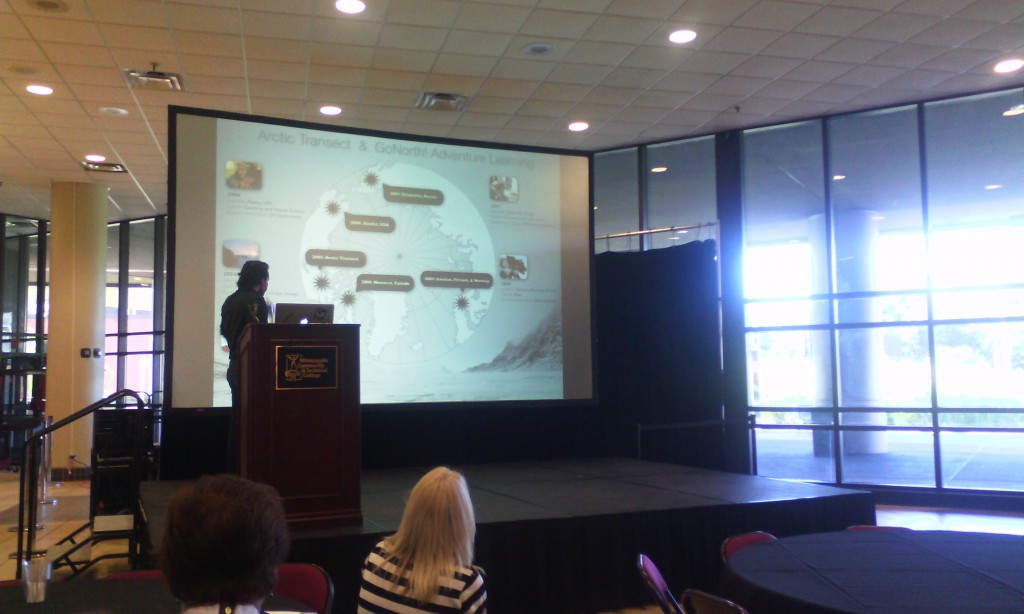
aaron doening
Engagement not completion
Design experience not product
Create change, not simply respond to it
He was a geography teacher : Dimitrina
Experience explore expand. Adventure based how to collaborate in ways we have not collaborated before pedagogical guidelines internet driven
Instructor – content – design
Today: first think is design, content, instructor. So how do we design learning environments is the most important one
Guide learners as designers. Constructivism. Design for meaning. Through the power of the story.
Geotetic design a learning environment learn geography using GIS
Situated movies (student-centered learning)
Grant Earthducation go to the most remote parts of the world to align their education with their culture, instead of what the government is downing as culture
Use of phone: whoever answers instructor’s question first, gets to pose the next question to the rest of the audience.
Design based research
Self-narrative, referencing the experience real world issues in real time
- reference knowledge . knowledge overlap. Technological pedagogical content knowledge.
Geotetic not only how prepare teachers, but desing learning environmwer of the story.
we explore: https://www.we-explore.com/
9.5 design as a learner.
the U Media Lab.
The Changing Earth. App GoX (instagram on steroids. tell their story through the app). How is this different from Google Earth
Raptor Lab (rehabilitate a raptor).
- design experiences
- build trust
- guide learners as designers
- recognize learners as experts
- encourage collaboration
- inspire self narrative
- reference the knowledge domains
- teach for change
- design as learner
adoering@umn.edi chasingseals.com @chasingseals
podcast pontification (audio version of blog self reflections)
Greg Steinke The U
A Digital Story Assignment using WeVideo

WeVideo is the Google response to iMovie cloud
The U is on Google email and thus google drive and all other google tools
The Center for Digital Storytelling. short videos, 3-5 min incorporate photographs with the author narration, reflection
Assignment (verbal directions). process (write a 2 page script, every page is about a minute of video), gather images that support the story; edit the script (rewrite); record audio to the script (use an app on the phone instead of WeVideo), WeVideo can edit the audio recording; edit the story, edit the photos to match the story; YourTube and/or Google+
working with faculty: is the digital story a good fit for your course? two questions: does the course have many writing assignments? does everyone have to do the same type of assignment? do you want to offer choices? do you want your students to share their work outside of the class? to you want to explore opportunities for students to develop 21 century skills?
google communities for sharing
wewideo has a tutorial at Center for Digital Storytelling
students can use the digital story for their eportfolio
the entire exercise is entirely based on mobile devices
time frame: scaffolding options
3d printing products were the tangible result of the project and the digital storytelling just the format to present
Google Drive master folder for the phone images and video; iOS apps: MoviePro, FiLMc Pro, VoiceRecord Pro (including mp3); Android: WeVideo
Storyboard template
Faculty Development Programs: Digital Storytelling Community of Practice
http://it.umn.edu/faculty-development-programs-digital-0
Poster sessions:
Brad Hokanson
http://dha.design.umn.edu/faculty/BHokanson.html
iPAD video kit:

Laurie Conzemius
Critical Thinking

ISTE: http://conference.iste.org/2016/
Joe Lau critical thinking
apps: Popplet blog.popplet.com http://www.popplet.com/ (mindmapping)
into the book: http://reading.ecb.org/
Kahoot – the token system. Polleverywhere https://blog.stcloudstate.edu/ims/2015/05/21/polls-and-surveys-tools-for-education/
Symbaloo https://www.symbaloo.com/home/mix/13eOcK1fiV zotero, easybib, delicious, diigo depending on the grade
youth voices; http://youthvoices.net/ replace social media like teachertube is trying to replace youtube
quandary games in education. https://www.quandarygame.org/ sim city
citizen science alliance http://www.citizensciencealliance.org/
Toontastic https://itunes.apple.com/us/app/toontastic/id404693282?mt=8 now free storytelling
coding and programming: https://www.makewonder.com/robots/dashanddot scratch
Osmo : https://www.playosmo.com/en/ $79.99 + give a set for free Stride principle as a parental involvement
chainlink;
kickword; https://play.google.com/store/apps/details?id=com.makario.wordkick
red herring (four categories) https://play.google.com/store/apps/details?id=com.BlueOxTech.RedHerring&hl=en
http://www.mathplayground.com/logicgames.html
http://www.mathplayground.com/thinkingblocks.html
evaluation:
telestory https://itunes.apple.com/us/app/telestory/id915378506?mt=8
explain everything http://explaineverything.com/
Exploring and Connecting 3D Printing to Teaching and Learning Jason Spartz, Saint Mary’s University of Minnesota
http://pubs.lib.umn.edu/minnesota-elearning-summit/2015/program/23/
http://pubs.lib.umn.edu/cgi/viewcontent.cgi?article=1023&context=minnesota-elearning-summit
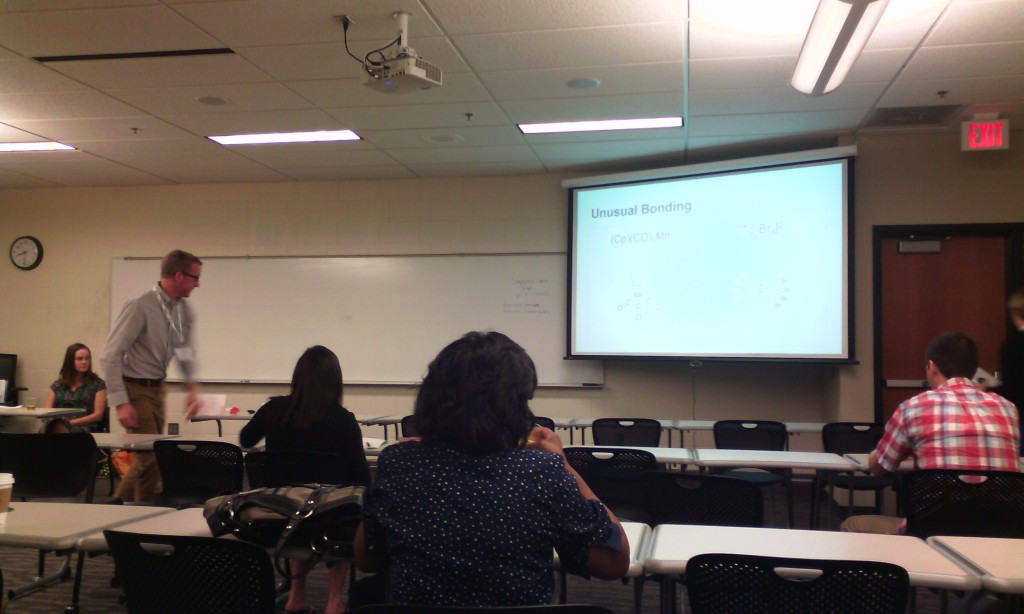
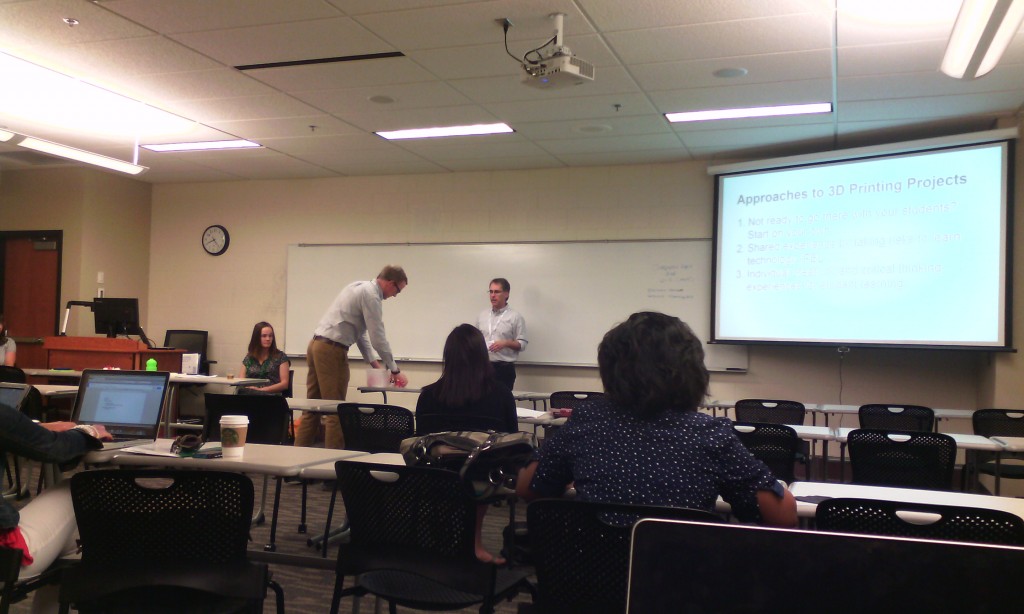
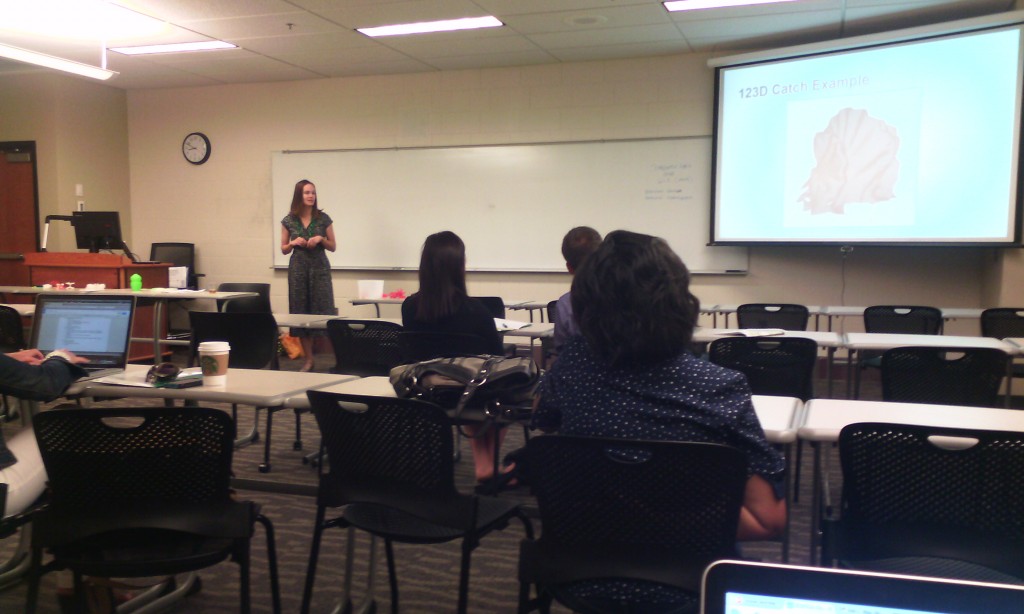
Jason Spartz, Saint Mary’s University of MinnesotaFollow
Lisa Truax, Saint Mary’s University of MinnesotaFollow
Karen Sorvaag, Saint Mary’s University of MinnesotaFollow
Brett Bodsgard, Saint Mary’s University of MinnesotaFollow
chemistry professor. 3D printing with different materials.
what else can be made (e.g. reaction vessel)
printing of atoms
crystalography dbase
Karen: pre-service teachers professor: how to use 3d printers and be comfortable with them. Steve Hoover. Thinkercad and Autodesk123D>
3D academy http://www.team3dacademy.com/index2.html. Pinterest board for3d Printing with resources
Lisa: graphic design. not intuitive. Rhinoceros (not free anymore). 123D strong learning curve. 3d printing will be incorporated in the curriculum. sculpture students and others don’t like fudging on the computer, but Adobe people love it. Some items takes up to 4 hours to print out. when working on the computer is difficult for some students to visualize the dimensionality.
collaborative learning opportunities.
no makerspace or fab lab. additional interest from the theater and business dept. 3d printing is connected to future work skills. new media ecology or media literacy set of skills.
the main presenter: build excitement and interest and gradually step back. how much material goes through and should we charge back. clean and maintenance involved; not too bad. better then a copier. plastic inexpensive. sizes with plastic – $25 and $50. how many project of a spool: depending on the size of the projects but considerable amount. two printers one art dept and one in the faculty dev area.
non profit visually impaired students. how 3d can make difference in special ed.
3d printing lab with access for everybody. ownership brings policy. where housed: neutral place.
only one printer is barely sufficient for faculty to figure out how to use it. purchasing two more if students and curricula to be involved.
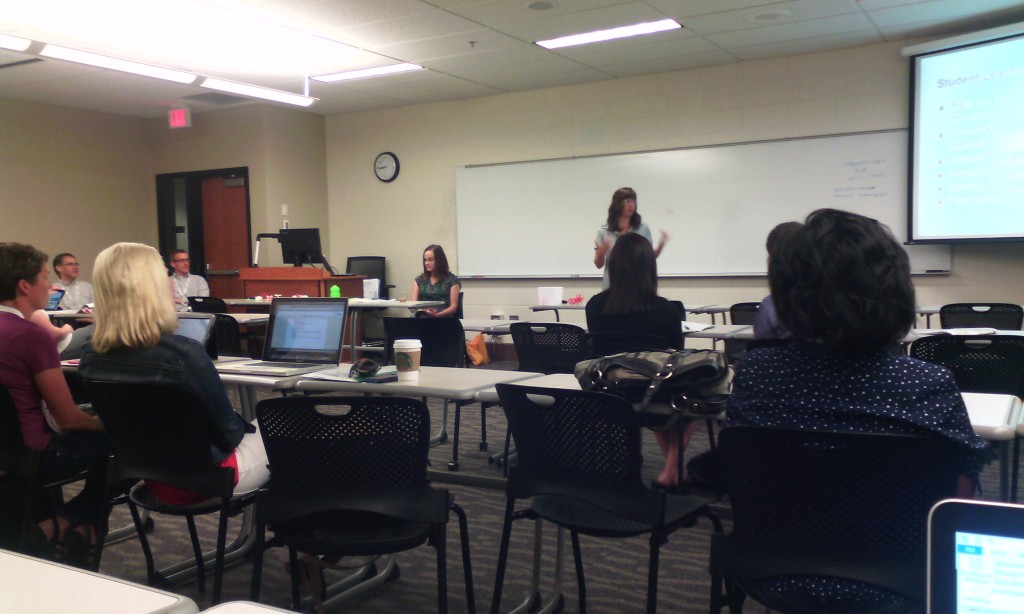



The Balancing Act: Team-Creating an eBook as an Alternative Method for Content Delivery Tom Nechodomu, University of Minnesota

Faculty Created digital stories – google “cultivaitng change series”
student created digital stories –
Susan Andre uses a slide titled “trust” to elucidate how the entire project was enabled. “trust” and “transparency” are sparse currency in the environment I work in. if she is right an ebook ain’t happening anytime soon at my place.
inclining habitat.
students involvement. use stipends. student artists. food for the video interviews. create a community, student centered.
people able to change the book.
copyright process; did you find it cumbersome. copyright permission center.
time span and amount of hours spent: 3-4 months per chapter.
Main speaker
David Wiley. Making Teaching and Learning Awesome with Open
MN Learning Commons
open educational resources
LUMEN
education – sharing feedback, encouragement with students passion about the discipline, yourself
open is not the same as free. free + permissions + copyright permission: 5 r = retain (make and own copies), reuse (use in a wide range of ways), revise (adapt, modify, and improve), remix (combine two or more), redistribute (share with others)
open:
free and unfettered access
perpetual, irrevocable copyright permissions
(look but don’t touch is not open)
tech enables OER permits
traditionally copyright materials on the Internet – not so good ; jet on the road
openly copyright materials on the internet _ yes: jet in the air
permission-less innovation. relatively inexpensive and broad permissions.
intellectual infrastructure of education: learning outcomes/objectives; assessments; textbooks. they are relatively expensive and narrow permissions.
disappearing ink strategies: buyback, rental, ebooks, online subscription
mad, glad, sad, rad: the grumpy cat. student success per dollar
opennetgroup.org/review
change in student learning: replace commercial with open books – small. realign, bigger change. rethink is the large change.
responsibilities:
attribution and meeting other license requirements
thin common cartridge: a way to bring the content to the CMS, but the content remains on the creative commons
disposable assignment: students hate doing them, instructors hate grading them. waste of time and energy
so what?
open education infrastructure: open outcomes, objectives, activities, educational resources
the culture of glued legos must be eradicated. open pedagogy. open credentialing model
summary: don’t settle for “affordable.” improve student outcomes. improve affordability. improve design / academic freedom
links generated from the discussion at my presentation:
http://www.tandf.co.uk/journals/access/white-paper-social-media.pdf
#tfsocialmedia
Social media objectives:
- promotion
- collection management tool
- Outreach
- teaching and learning
Opportunities and challenges
- opportunity to build a sense of community between the library and its users
- the variability of skills across library staff for using social media effectively, striking the right tone between professional and personal, coordinating activities across the institution to avoid duplication
- maintaining visibility for the library brand and copyright issues relating to hosting library resources on social media sites
Policies and management:
- Librarians are divided on the benefits of introducing formalized social media policies and plans. About a third of libraries responding to the Taylor & Francis survey had a policy in place, but over 40% had no plans to introduce one
- Some believe that representing the library as a professional function with a
consistent tone is the priority, while others believe that a more human approach is important, with individual staff free to bring their own ideas and personalities to social media activities.
Effectiveness and assessment:
- difficult to prove return on effort and that the time required to do this was a major barrier to more comprehensive analysis of impact
- framework for evaluation, so it is likely that assessment against commonly agreed metrics will become an increasingly important part of social media activity within the library in the near future
Current Social Media Practices:
- In a study from the mid 2000s (Cantrell and Havens1 ), most library directors in the US when questioned about social media said they did not think that libraries had a role in social networking
- A more recent study from 2012 (Kai-Wah Chu and Du4) shows how use of social media by the library has now become mainstream. In this survey of libraries in Asia, North America and Europe, 71% were found to be using social media tools with a further 13% saying they planned to use them
Advantages of using social media
n Financially the costs of using social media are perceived to be low;
n It requires little training;
n It promotes library services and disseminates news quickly, delivering this information more directly to library users;
n It increases engagement and interactions with library users;
n It helps gather feedback to enhance user services;
n The promotion of library holdings via social media can help increase usage of content;
n It enhances communication both within the library and with other departments;
n It can be used for outreach activities through onward sharing, well beyond the institution itself, helping build connections and reputation more broadly
Social Media Objectives: graph on page 8 of the PDF document:
A To promote events
B To promote library services
C To promote resources/collections at the library
D To update on library refurbishments
E To promote new acquisitions
F To promote library guides, exhibition guides
G To connect with new students joining the university
H To engage with the academic community
I To connect with the wider community beyond the university e.g. the town in which the institution is based
J To connect with distance learners
K As a customer services tool- complaints, suggestions, enquiries, feedback
L To highlight subject specific information
M To connect with potential students
N As a teaching tool to promote information literacy, technology and writing tips (not library based)
O To promote courses
P As a research tool to locate official documents and studies
From UK-based focus group: “The library is a programme, not just a building.”
Channel preferences: Graph on page 10 of the PDF document
SOCIAL MEDIA USES Table on p 13 of the PDF document
Twitter n Distribute library news and information
n Provide customer service
n Build connections with researchers
n Build connections with other librarians and institutions
Facebook n Distribute library news and information
n More social and less formal than Twitter – share photographs and run competitions
n Arrange events including tracking RSVPs and sending event updates
n Engagement with students
Pinterest n Promote general library collections, digital and archive special collections and information literacy
n Set up of online repositories for students to pin researched references as part of
collaborative group work
n Display book titles to save time browsing and promote new titles
n Provide an arena for students and course leaders to pin reviewed and recommended reading
for a particular topic
n Develop communities with other online libraries
YouTube n Streaming film collections
n Instructional ‘how to’ videos teaching information literacy skills and how to use library
services and resources
There are also a number of other social media products that are being used by librarians that reflect regional
preferences and the need for the specific functions offered by niche applications.
Collection usage and discovery: Graph on p. 15
Teaching and learning
From US-based librarian interview: “The trend in education now is to create environments that foster collaborative learning. Faculty have ditched textbooks and course management systems in exchange for a Facebook page for their class, or a wiki, or a blog. These online environments are fun; students already know how to use them and are more motivated to comment, discuss and share in these environments than a dry CMS.”
Social media policies and management, p. 18
73% of respondents stating that they believed more roles dedicated to social media would appear in the library in the future.
Effectiveness of social media
From UK focus group: “We keep track of something particularly successful, then we redo the campaign 6 months later.”
From US focus group: “We have very few interactions with anyone on our Twitter feed.”
“Twitter is definitely the best platform, because we hashtag all of our posts with the keyword
of the publication, and so for the academic audience, once they click it’s going to pull up all
of the similar publications under that topic.
Promoting library social media channels
From UK focus group:
“We retweet each other to encourage new followers.” My note: Suggested by me regarding SCSU_Library for Twitter and Pinterest and SCSUTechinstruct but “considered” (in local lingo, slow death of the idea)









